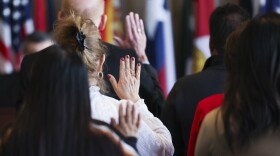Hello, I’m Dennis Garcia. I was born in 1951 in Garden City, Kansas. Today, I’d like to share with you a family story about two great historical events that took place in the 1930s, the Great Depression and The Dust Bowl.
If you ask a person born after 1980 about the Great Depression and Dust Bowl, they might recall from their history classes video images of unemployed men standing in a long line waiting for a serving of soup, and photos of a wooden farm house out in the open prairie with drifts of dirt blocking doorways and windows. It’s unlikely they understand the individual hardships suffered beyond those images. And they probably don’t realize that the Mexican families living and working on the high plains suffered similar hardships and poverty.
For most American families The Great Depression began with the stock market crash in New York City on Black Tuesday, in October 1929. But for my grandfather Jose Garcia, the crash occurred earlier that year when he suffered a hernia while working for the Santa Fe Railroad in southwest Kansas. At age forty-nine his work with the Santa Fe ended. The only other work available to him in Garden City was migrant farm work. Most of that work was in the sugar beet fields surrounding Garden City. When the sugar beet season ended the family traveled to California to pick fruit and other crops. I once asked my father what the depression was like, he said, “Depression? What Depression? My whole life was in a depression.”
With each passing year during the 1930s, a greater number of dust storms struck the high plains. Perhaps the storm most remembered occurred on Palm Sunday, April 14, 1935. Most can remember where they were when the storm hit, and what they did for safety. The storm struck the Oklahoma panhandle directly, but Garden City was also hit hard.
About 1:30 that afternoon on Palm Sunday my father and two friends left church after attending Catholic education classes. The boys began walking home heading east to their barrio a mile away. My dad recalled that after two blocks, he looked back towards the church. What he saw startled and frightened him. A dark, massive, rolling cloud of dust reaching into the sky was coming directly at them. He shouted for the other boys to look. They saw the dust cloud and began to run.
They ran down the sidewalk, but they were quickly covered in complete darkness. They began calling out for one another. They were able to find each other and hold on despite the blowing dust. My dad saw a faint light through the dust and shouted to the others that they should walk towards the light. They headed for the light, but it did not appear any closer.
With dad in the lead they kept their course. Eventually, his face bumped into an object. He realized he had walked into a wall of a house. Moving his hands along the wall, he followed it until he saw the light through a window. The boys had reached the front door. My dad knocked and knocked four or five times before the door opened slightly. He yelled out to be let in until the storm passed. Surprisingly, an elderly, petite, white woman allowed the three Mexican boys into her home. She told them that they could remain until the storm passed. After the storm cleared enough for them to see their way home. My grandmother, believing the boys had remained at the church, said a prayer in thanks.
I hope you enjoyed this story. Read more about my family’s experiences on the high plains in my book, Marine, Public Servant, Kansan: The Life of Ernest Garcia. It’s available from your favorite retailer and through the University Press of Kansas. I’m Dennis Garcia and many thanks to High Plains Public Radio.
NOTE ON THE MUSIC
Los Madrugadores (The Early Risers) gained immense popularity within the Mexican-American community during the Great Depression of the 1930s. Based in Los Angeles, Los Madrugadores was organized by Pedro J. González, a political activist born in Mexico. Throughout its existence Los Madrugadores was composed of different ensembles of male and female singers and musicians. Smithsonian Folkways







